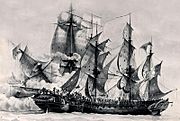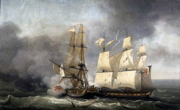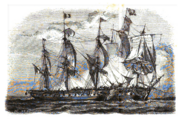Action of 14 December 1798 facts for kids
Quick facts for kids Action of 14 December 1798 |
|||||||
|---|---|---|---|---|---|---|---|
| Part of the French Revolutionary Wars | |||||||
 Pierre Ozanne's depiction |
|||||||
|
|||||||
| Belligerents | |||||||
| Commanders and leaders | |||||||
| Strength | |||||||
| 1 corvette | 1 frigate | ||||||
| Casualties and losses | |||||||
| 25 killed 30 wounded |
15 killed 39 wounded 1 frigate captured |
||||||
The action of 14 December 1798 was a surprising sea battle. It happened between a British frigate called HMS Ambuscade and a French corvette named Bayonnaise. A frigate is a medium-sized warship, while a corvette is smaller. Even though Bayonnaise was much smaller and had fewer guns, it managed to capture the larger Ambuscade.
Contents
The Ships and Their Mission
On December 14, 1798, the French corvette Bayonnaise was sailing near Ré island. Corvetts were fast ships, but not as powerful as frigates. At the same time, the British frigate Ambuscade was cruising near Oléron island. Captain Henry Jenkins commanded the Ambuscade.
The Ambuscade was waiting to meet another British ship, HMS Stag. Their job was to block the Gironde estuary. This meant stopping enemy ships from entering or leaving the river mouth. The Bayonnaise had 24 guns and a strong crew. It also carried 40 soldiers from the Régiment d'Alsace.
The Chase Begins
At dawn, the Ambuscade spotted the Bayonnaise. The British captain thought it was their friendly ship, Stag. But the Bayonnaise also saw the Ambuscade. The French captain knew it was a bigger British warship. So, the Bayonnaise quickly turned around to escape.
This move made the British realize the ship was French. The Ambuscade immediately started chasing the Bayonnaise. Around noon, the Ambuscade got close enough to fire its cannons. The battle was about to begin.
The Battle at Sea
The fight started, and after about an hour, the British ship was winning. The Ambuscade had damaged the hull and sails of the Bayonnaise. The British frigate tried to move behind the Bayonnaise to fire along its length. This is called raking fire.
Suddenly, one of Ambuscade's cannons exploded. This explosion destroyed the ship's small boats. It also killed or wounded 13 sailors. The British crew became confused. The Bayonnaise tried to use this chance to escape south. But the Ambuscade chased it again and caught up around 3 PM.
Close Combat
The Ambuscade sailed alongside the Bayonnaise, moving past it. Then, the Bayonnaise quickly turned and rammed the Ambuscade. The front part of the Bayonnaise (its bowsprit) crashed into the back mast of the Ambuscade (its mizzen). This injured some British sailors and tangled the two ships together.
Both ships fired one last big volley of cannon fire. Then they closed their gun openings. The Bayonnaise lost many men, and its captain, Richer, had an arm shot off. But French grapeshot (small metal balls) and musket fire swept across the Ambuscade's decks. Most British officers were wounded and taken below. Only Lieutenant Joseph Briggs was left in command, and he was not well.
The Boarding
The French sailors used the Bayonnaises bowsprit like a bridge. They climbed onto the taller Ambuscade. They quickly took a small cannon loaded with grapeshot. They used it to clear the front part of the ship. A powder box exploded on the Ambuscades quarterdeck. This destroyed the steering wheel and a boat.
After a bloody fight that lasted 30 minutes, the last British officer standing, William Beaumont Murray, surrendered the Ambuscade. During the battle, the Ambuscade had 15 sailors killed and 39 wounded. This included Captain Jenkins and his two lieutenants. The Bayonnaise had 25 killed and 30 wounded, including Captain Richer.
What Happened Next
The Bayonnaise was badly damaged. It had lost most of its sails and was leaking. The Ambuscade had lost its mizzen mast and had damage from the explosions. But it was still able to sail. The Ambuscade then towed the Bayonnaise to a French port. They arrived the next day. The British ship Ambuscade was taken by the French and renamed Embuscade.
The French captain, Richer, was promoted three ranks for his bravery. Other officers from the Bayonnaise were also promoted. Major Henri Louis Lerch received a special award for his actions during the boarding. Captain Jenkins of the Ambuscade later faced a military trial. He was accused of letting his ship be captured. But he was found innocent.
The French government used this battle to show their strength. They ordered several paintings of the event. One famous painting by Louis-Philippe Crépin is now in a museum in Paris.
- Representations of the battle in art and propaganda
See also
- Action of 12 August 1782, a similarly unbalanced action between the 28-gun sixth-rate HMS Coventry, with a crew reinforced by soldiers, and the French 32-gun frigate Bellone. Coventry managed to avoid capture and make good her escape.







